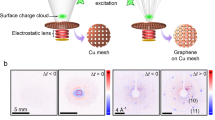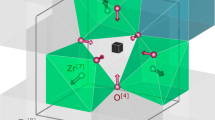Abstract
AN electron diffraction system for the quantitative investigation of rapid phase changes in solids has recently been completed. The system will record an electron diffraction pattern of the Debye–Scherrer ring type in 50 msec., giving the electron intensity at the peaks of strong reflexions to an accuracy of 2 per cent. The system gives an improvement in speed of direct recording of about four orders of magnitude1, and is thus attractive for investigating quantitatively rapid changes in solids such as polymorphic transformations, transitions from the amorphous to the crystalline state, diffusion in alloys. It is also suitable for investigating controversial questions in electron diffraction such as the transition from geometrical to dynamic diffraction conditions2,3.
This is a preview of subscription content, access via your institution
Access options
Subscribe to this journal
Receive 51 print issues and online access
$199.00 per year
only $3.90 per issue
Buy this article
- Purchase on SpringerLink
- Instant access to full article PDF
Prices may be subject to local taxes which are calculated during checkout
Similar content being viewed by others
References
Bagdyk'yants and Alekseev, Bull. Acad. Sci. U.S.S.R., Phys. Ser., 23, 766 (1958).
Pinsker, Adv. in Electronics and Electron Physics, 11, 355 (1959).
Halliday, Proc. Roy. Soc., A, 254, 30 (1960).
Smith and Oatley, Brit. J. App. Phys., 6, 391 (1955).
Author information
Authors and Affiliations
Rights and permissions
About this article
Cite this article
GRIGSON, C. High-Speed Direct-Recording System for Electron Diffraction. Nature 192, 647–648 (1961). https://doi.org/10.1038/192647a0
Issue date:
DOI: https://doi.org/10.1038/192647a0
This article is cited by
-
Some Applications of an Improved Scanning Electron Diffraction System
Nature (1965)
-
Scanning Electron Diffraction from Solids
Nature (1965)



